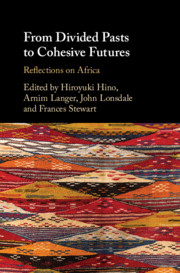Book contents
- From Divided Pasts to Cohesive Futures
- From Divided Pasts to Cohesive Futures
- Copyright page
- Contents
- Figures
- Tables
- Contributors
- Foreword
- Acknowledgments
- Introduction: Understanding Processes of Change in Social Cohesion: Learning from Comparative History
- Part I Social Cohesion in Africa: Case Studies of Past and Present
- Part II Policies and Institutions for Social Cohesion
- Part III Conclusions and Policy Recommendations
- Index
- References
Part I - Social Cohesion in Africa: Case Studies of Past and Present
Published online by Cambridge University Press: 05 August 2019
- From Divided Pasts to Cohesive Futures
- From Divided Pasts to Cohesive Futures
- Copyright page
- Contents
- Figures
- Tables
- Contributors
- Foreword
- Acknowledgments
- Introduction: Understanding Processes of Change in Social Cohesion: Learning from Comparative History
- Part I Social Cohesion in Africa: Case Studies of Past and Present
- Part II Policies and Institutions for Social Cohesion
- Part III Conclusions and Policy Recommendations
- Index
- References
Summary
This chapter argues that ethnicity is a universal human characteristic; it is an identity whose moral economy of mutual social relations causes internal dispute more continuously than external contexts cause interethnic competition. Ethnicities are mixed, shared, and subject to constant change in their own self-awareness and their inter-relations with others. The last two centuries of Kenya’s history illustrate this point. In the stateless, precolonial, past, different ways of taming the varied regional environment were the greatest influence on the nature of “ecological ethnicities” that shared ideas, took in each others’ economic migrants, and engaged in little “inter-tribal war”. Under colonial rule, access to scriptural literacy and arguments about how best to resist subjection caused much a sharper, patriotic, ethnic self-awareness. Regional inequalities in development, especially the triumph of agriculture over pastoralism, made ethnicity more competitive – a condition greatly emphasised when independence gave some Africans a centralised coercive power over others. Kenya has only recently adopted a devolved constitution that may defuse this often lethal competition but it is as yet too early to say.
Keywords
- Type
- Chapter
- Information
- From Divided Pasts to Cohesive FuturesReflections on Africa, pp. 13 - 190Publisher: Cambridge University PressPrint publication year: 2019



